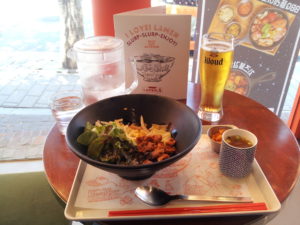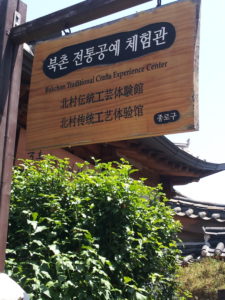
Hello, I’m S.J. Pendergraft! Recently, I traveled to Seoul, Korea, staying with an old Army buddy while exploring what the capital had to offer. Staying in another country was a crazy and wonderful experience, and I’m glad I had the chance. These columns will hopefully give you an idea of what to expect should you visit Seoul. So let’s get started!
Hanok is the term for traditional Korean architecture. Despite the modernization of Seoul, several examples of hanok architecture are preserved, and the largest example is the Bukchon Hanok Village. In the imperial days, Bukchon was the residence of choice for high-ranking government officials and bureaucrats, but today it is a simple residential neighborhood. Although people still live there, visitors can walk around the area, visiting specific outlook points to view the village and visit the stores and restaurants.
The area is divided into three zones: A (Samcheong-dong), B (Gahoe-dong), and C (Insa-dong). Visitors’ guides are provided in multiple languages with detailed maps listing places of interest.
A Zone, the neighborhood of Samcheong-dong, is the largest area and is mostly a shopping district. There are plenty of fashionable and trendy stores, such as Etude House (the Korean version of Sephora) and Boy London. One fun place is Happy Pills, a candy store built in the style of a dispensary. You pick a dosage size, fill with the candy of your choice, and they seal the lid of your “prescription.” For lunch, Lamen;S has a new take on traditional Korean food, or there’s Original Chicago, a pizza joint that serves very good beer.



B Zone, Gahoe-dong, is really where the Hanok Village starts. There are several lookout points on the guidebook map where you can view the area, but if you walk around the area long enough, you will see plenty. Hidden down Bukchon-ro 12-gil, along the street that dives A Zone from B Zone, you’ll find the Bukchon Traditional Crafts Experience Center, the Donglim Knot Workshop, the Hansangsoo Embroidery Workshop, and Gahoe Folk Painting Workshop. Here visitors can make small versions of traditional Korean crafts, such as glasswork, masks, decorative knots, and calligraphy, perfect gifts for family and friends back home (and cheaper than buying at tourist stalls), for about ₩10,000 KRW ($8 USD/11$ CAD). There’s a stall selling taiyaki ice cream sundaes (taiyaki is a sweet pastry in the shape of a fish.) and a café selling mojitos in a souvenir bottle. And if you stroll along the streets, there are small independent arts and crafts stores, from jewelry to toys. The Papa & Toy is a fun little store with Marvel and DC merchandise.




C Zone isn’t really much of a historical area, consisting of the shopping district, which I’ll cover in another column. Being more of a trendsetter area, there’s still plenty of shopping, but if you want souvenirs, the above mentioned Bukchon Craft Center is a better place, both price-wise and for the experience of making the craft, instead of just buying.
Another perk of Bukchon is the proximity to several palaces (Gyeongbokgung Palace, Changdeokgung Palace, and Jongmyo Shrine). A popular experience is to visit one of the numerous hanbok studios and have your picture taken. I recommend the Hanok Homestay Information Center, where you can take pictures for only ₩8,000 KRW ($7 USD/9$ CAD). There are other studios where you can rent hanbok for several hours and visit the palaces and temples for free. So don’t be surprised when wandering the traditional village you see people dressed in traditional garb.

The Hanok Village is a great place to stroll and visit, seeing sights both ancient and modern in one setting. You can reach Bukchon by taking the Line 3 subway to Anguk Station.
Check out VisitKorea for more information.

![[REVIEW] ‘THE HUNT’ IS SURPRISINGLY SOLID SATIRE WITH A STAR PERFORMANCE AT ITS CENTER](https://geekd-out.com/wp-content/uploads/2020/03/The-Hunt-feature-150x150.jpg)

